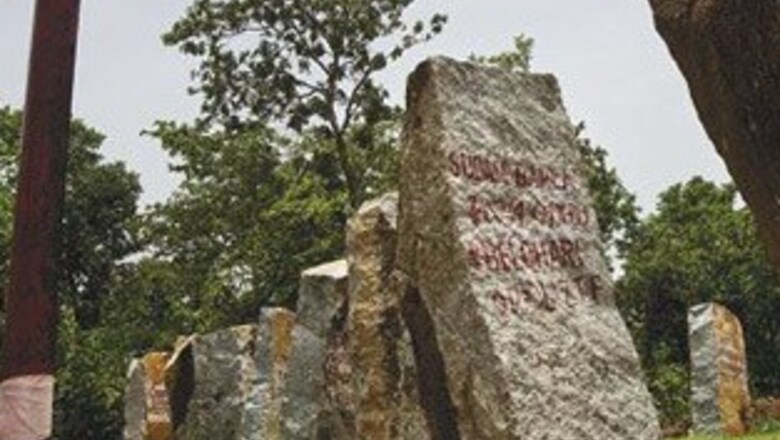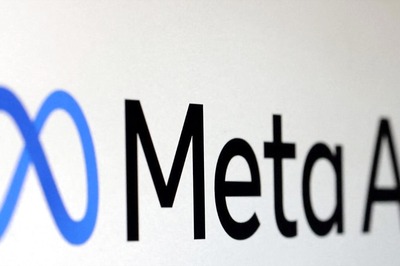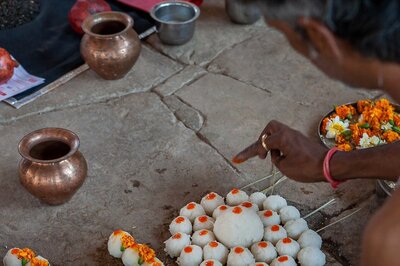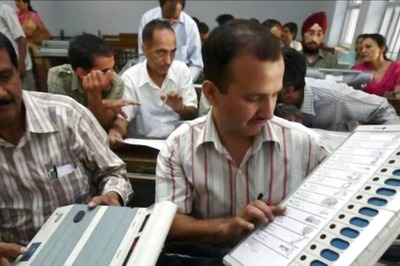
views
Tribals in the state want to fence their mineral-rich earth from invading metal companies. Both sides need an open mind if this stalemate is to be broken.
“What will you gain from knowing about the struggle?” asks Rabindra Jarika. The 31-year-old farmer looks ill. “Had gone out to the fields and got wet in the rains,” he explains as he walks past a stubby hay-filled silo and settles into a small and dimly-lit room. There are a couple of cots. Behind the cots are spades and pickaxes. A dank smell hangs in the air.
Jarika is a youth leader of the Ho tribe from Chandiya village in the mineral-rich state of Orissa. He has masters in sociology degree and was teaching when he decided to come back to the village to “help my people”. He now spends most of his time leading a protest against a steel plant that threatens to displace his tribe and their traditional way of life.
Chandiya flanks the industrial hub of Kalinganagar and is one of the six villages that are holding out against Tata Steel’s plans to set up a Rs. 30,000-crore plant. The plant will come up on land that has sustained a self-sufficient economy for countless generations of local people.
Kalinganagar is not alone. There is Kalahandi and there is Dhinkia. All are divided houses. Divided between industrialisation and agriculture; divided between tribals and heartless urban bureaucrats; divided between ambitious global companies and tribals who are suspicious of such ambitions. Tribals living in these parts find, much to their consternation, that their fertile land has vast reserves of iron ore and bauxite. Companies want to mine them. The Orissa government wants the economic activity spurred by these projects. But invariably, it would mean the tribals would lose their land, livelihood and culture.
The people don’t want that to happen. They are happy farming. The outcome of this three-way joust will decide the fate of investment worth Rs. 3 lakh crore from companies such as Tata Steel, South Korean steel giant Posco and metals major Vedanta. Such a large number makes no sense to Jarika though.
“Our families have been living here for generations. We will not move and will continue our agitation,” he says.
Those are brave words. Outside Jarika’s house is a narrow lane that leads to a patch of green. On the horizon, grey smoke spews out of a phalanx of steel plants that have come up in the region in the last few years. Don Quixote tilted at windmills, Jarika is fencing with steel plants.
State of Contradictions
The dilemma of industrialisation in Orissa is decades old. The state has two things in enormous measure: Poverty and minerals. It has 60 percent of India’s bauxite reserves, 25 percent of coal, 28 percent of iron ore, 92 percent of nickel and 28 percent of manganese reserves. Orissa’s tribals account for more than a fifth of its total population, the highest proportion for any state. The state government wants industry to create jobs, increase tax revenue and take the region out of poverty. Nothing that other states have not done, but in Orissa, the route to industrialisation cuts through the mineral-rich lands inhabited by the tribals.
PAGE_BREAK
People would have welcomed the transformation if only Orissa’s track record had been better. Past regimes have brought in projects unmindful of the impact on local people, or any sympathy for the displacement they caused. The past decade alone saw two million people being affected by the influx of plants. Half a million people were sent out of their homes. Three out of four displaced persons were tribals.
The memory of 1955 still rankles. Nicholas Barla, a Catholic priest and social activist says, “The tryst of Orissa people with industrialisation is not new but began from the very first two mega projects — Rourkela Steel Plant in 1955 and the Hirakud Dam that was built a year later over the Mahanadi river. Even today, many among those displaced by these two projects are living homeless.” Industry experts, however, point out that the Rourkela Steel Plant, one of the three mega plants operated by the state-owned Steel Authority of India, provided direct employment to almost 40,000 people. And it was the demand for another mega steel plant in Orissa, where unemployment rate is a high 8 percent, which led the late Biju Patnaik to plan the Kalinganagar industrial complex in 1992.
Today, his son Naveen Patnaik is stepping up the presence of industry. Naturally, it is the mining and metal companies that are vying for a piece of rich mineral wealth of his state. The recent elections to the state Assembly took place in the ominous backdrop of intense protests. But if the results are any indication, Naveen Patnaik’s industry drive has got the vindication it needed. His Biju Janata Dal (BJD) won 103 of 147 seats. It even won in some pockets where protests were the strongest. For instance, it won seven seats in Jaipur district where Kalinganagar is located.
The tribals are disconcerted. “I don’t know how that happened,” says a rueful Jarika. “May be it was BJD’s scheme of Rs. 2 per kg of rice, or its pre-election alliance with Left parties,” says Jarika. Whatever may be the cause, Patnaik can push ahead with the projects now. The government is now underplaying the seriousness of the protests. “Wherever big projects come up, there will be opposition. These things are common,” says Raghunath Mohanty, the state minister for steel, mines and industries.
The reality is much more bitter. Some people have had to pay with their lives to sustain the protests. In January 2006, a protest against the Tata Steel plant turned violent and police opened fire. As many as 14 tribals were killed. Jarika lost two of his friends. “Ever since steel plants came up in 1990s people in Kalinganagar have only suffered,” says Jarika. “After the firing we totally lost our trust in the government and the companies.”
Standing testimony to the bloody chapter is a memorial complex at the centre of the village. Pillars resembling Stonehenge have been erected to salute their martyrdom.
A Perpetual War
The air is thick with tension and suspicion in Chandiya. Strangers are not welcome in the village. Any vehicle that is not from the village is followed and its licence plate is noted down. Visitors are often stalked. After all, not everyone is protesting against the plant and that has divided the village. “[A] division between protestors and those who are for the project has already taken place and there is a real chance of clashes taking place,” says Rajkishore Meher of Nabkrushna Choudhary Centre for Development Studies. Meher has studied industrialisation and displacement in Orissa, Madhya Pradesh and Jharkhand.
The biggest reason for the advent of industry, job creation, doesn’t cut ice with the villagers in Dhinkia, located near the Paradip port and about 100 kilometres south of Kalinganagar. They have refused to be impressed by India’s biggest foreign direct investment proposal: Posco’s plan to invest Rs 55,000 crore for a steel plant in the vicinity. The project will be the centre-point for industrial development around the port region, another Kalinganagar designed by the state government.
PAGE_BREAK
Set amidst small lakes, betel yards and paddy fields, Dhinkia is picturesque. Not for Posco executives though. For most of the last four years, Posco executives, police personnel and officials from the local administration have failed to even enter the village. Access to the six entry points to the village is restricted by bamboo gates carrying a tin board saying Posco Pratirodh Sangram Samiti (Committee for Action Against Posco). A group of 50 men and women guard the gates round the clock.
Of the eight villages which Posco’s plant will displace, Dhinkia is the only one that has not responded to overtures from the steel giant.
“Why should we?” asks Shishir Mahapatra, the village head who recently led the Samiti candidates’ clean sweep in the local body elections. He is sitting in a courtyard of a small temple in the centre of the village, surrounded by about 200 men holding their weekly meeting to decide their next action.
“We do not want any jobs from Posco. We are fully self-dependent. This area earns about Rs. 30 crore every year from the betel leaves business alone. Leaves from here are sold even in faraway places like Banaras in Uttar Pradesh, the place known for pans,” he says proudly, “Not one of our youngsters is jobless.” It is another matter that not everyone of the younger generation wants to work in the farms.
Molu Mallik is one of the waiters at the newly constructed hotel targeted “to cater to the expected rush of businessmen” as many projects around the Paradip port come up.
Mallik is from Dhinkia and instantly strikes a different note when asked if he supports the agitation against Posco. “No, I want the project to come. My parents do support it, but they just listen to other elders in the village. I don’t want to go back to farming,” says Mallik, who recently graduated from a nearby college.
Officials at the Bhubaneshwar-based office of Posco sense the resistance and admit that they are in touch with a few of the villagers within Dhinkia despite the virtual ban on outsiders. “It is not that we do not know what is happening. We do not want to force the project on the people but want to talk to them across the table. But how can we, when we are not allowed inside,’ says Dr. S.K. Mahapatra, responsible for resettlement and rehabilitation policies within the South Korean company.
Another official, on condition of anonymity, adds that the company is “expecting to get all the clearances soon and will begin the plant construction within this year.” He adds, “We stand by our timeline for the first phase of 4 million tons, which should be ready by 2012.” At the same time, Mahapatra separately reiterates that “we do not want violence.”
The message from the state government is similar, even though minister Mohanty keeps asserting to TV cameras that it “will go for industrialisation at all costs”. The shooting incident has mellowed the government. “The state has learnt its lesson from the Kalinganagar episode and we do not want a repeat,” says Ashok Meena, managing director of Industrial Promotion and Investment Corporation of Orissa Ltd., or IPICOL. Meena makes it clear that only those projects that “fulfill all the criteria set by the state, including those on rehabilitation, environment and have the confidence of the local people” will be cleared.
Treading Softly in Kalahandi
Vedanta Resources’ public relations drive shows the change in mindset among the pro-industry forces. It wants to win over support for its controversial bauxite mining project in the Niyamgiri hill range in Kalahandi district, about 500 kilometres west of the state capital. Non-governmental organisations alleged that the project might spoil the local ecosystem and displace native Dongria Kond tribe, who deem the hills as their spiritual abode. So, Vedanta is moving cautiously.
“We have recently taken over 800 aanganvaadis (state-run agencies for women and child welfare) in Rayagada, where most of these tribals live,” says Mukesh Kumar, who is heading Vedanta’s local alumina and aluminum operations. That is not all. Kumar claims that the company is spending Rs. 30 crore annually for the development of the region and is also training those displaced by its alumina plant, which has begun operations.
One of its showcase initiatives is the strawberry cultivation across 15 acres. But this doesn’t amuse Siddharth Naik, a veteran social activist who took part in a protest that led to the closure of the mining project of Balco in the 1980s. Ironically, Vedanta owns Balco today. “What would people in Kalahandi, one of the poorest in the country, do with strawberries?” Naik asks. But Vedanta hopes that the drives will help change the mood among the Dongria Kond and promises that none of the 8,000 natives from the tribe will be displaced because of its mining project.
While it might be still a long way from winning the complete support of the natives, an impression has been made. At Tirlochanpur, a village at the Niyamgiri foothills inhabited by Dalits, support for Vedanta’s project has both unified and divided the people. “We support the company as it has plans to bring electricity and water to our homes,” says 30-year-old Babu Lal.
However, he and two of his friends are blocking the road that takes to the upper reaches of the hills, home to the Kond tribe. “Vedanta last week had given us a contract to build roof for its health clinics in the area. But yesterday it awarded the same contract to our competitor from the village. We won’t let any vehicle pass until the order is reversed,” says a defiant Babu Lal.
The three are joined by other youngsters from the village and soon it’s a party! A beer bottle is uncorked and as if on cue, two Dongria Kond tribesmen come walking. “We will support Vedanta if it benefits us but if our land is taken away we will fight till our last breath,” says Dikcha Majhi in a defiant tone. Babu Lal’s friend points out that a Vedanta vehicle was burnt down last month and the driver seriously hurt after company officials went to the Kond village uncalled.
But that is little respite for Naik, the activist. He is a worried man. In a sign that his intelligence network in the area is weakening, he learns a week late that Vedanta has taken members of the Kond tribe and other nearby villagers on a tour to the nearby mining facilities of the state-owned National Aluminum Company. More alarmingly for him, the tour is successful for Vedanta as a member of the tour, a Dalit from a nearby village says, “They showed that we will not be displaced by the mining. Yes, we will support Vedanta’s project and also talk to the Kond people.”
The government and companies have not yet earned the people’s trust fully. “It will be a mistake if the government thinks that its recent victory in the elections is a vote for industrialisation. If you look carefully, all the seats where it lost are the ones where most of the industrialisation is taking place or is planned. Otherwise, there are more Kalinganagars waiting to happen,” says Prafulla Samantray, a well known social activist in the state.
Find this article in Forbes India Magazine of 03 July, 2009




















Comments
0 comment